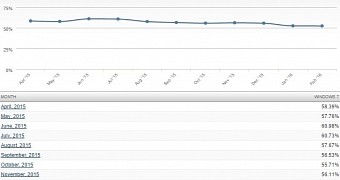The free Windows 10 upgrade offer announced by Microsoft in mid-2015 is supposed not only to help boost the transition to the new operating system but also to get users off Windows 7, as this version could easily become the company’s new headache when support ends in 2020.
Windows 7 is often referred to as the best desktop operating system released by Microsoft, and this is one of the reasons so many people are holding onto it and refusing the upgrade to Windows 10.
Mainstream support for Windows 7 SP1 had already ended on January 13, 2015, but extended support will come to an end on January 10, 2023, and unless everyone upgrades by that time, Microsoft is very likely to face another “Windows XP moment.”
“Another Windows XP moment”
Back in April 2014, when Microsoft pulled the plug on Windows XP, more than 25 percent of PCs were still running it, which obviously led to more security risks for everyone. Without a doubt, Microsoft’s trying to avoid this from happening again with Windows 7, and this is one of the reasons the company’s pushing so hard for the Windows 10 upgrade.
And statistics provided by Net Applications for Windows 7 show that, since the launch of Windows 10, the operating system has declined only 8.3 percent. Furthermore, it even improved its share from 55.71 percent in October to 56.11 percent, as it’s believed that some Windows 10 users decided to downgrade.
Windows 7 is currently at 52.34 percent, and with the free Windows 10 upgrade offer coming to an end in July, the transition to the new operating system is very likely to slow down. Of course, it all depends on how Microsoft plans to handle the post-free Windows 10 upgrade era, as the company could very well extend its offer and make the new OS available free of charge for a longer period of time.
In the meantime, however, it’s very clear that Windows 7 is holding steady despite the arrival of Windows 10, and although the 2020 deadline is still very far, it’ll be interesting to see how Microsoft manages to deal with its 50 percent market share.

 14 DAY TRIAL //
14 DAY TRIAL //